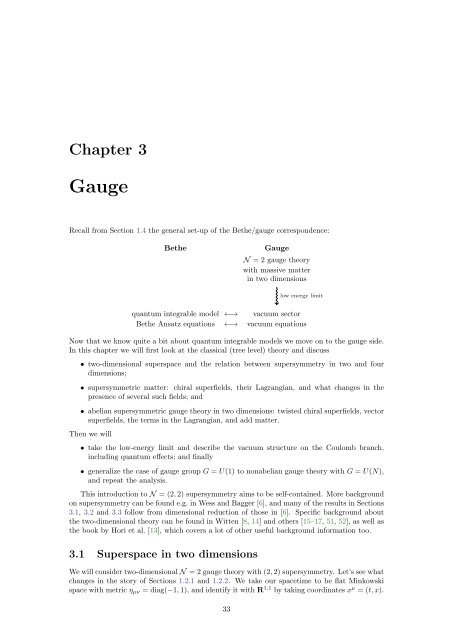The Bethe/Gauge Correspondence
The Bethe/Gauge Correspondence
The Bethe/Gauge Correspondence
Create successful ePaper yourself
Turn your PDF publications into a flip-book with our unique Google optimized e-Paper software.
Chapter 3<strong>Gauge</strong>Recall from Section 1.4 the general set-up of the <strong>Bethe</strong>/gauge correspondence:<strong>Bethe</strong><strong>Gauge</strong>N = 2 gauge theorywith massive matterin two dimensionslow energy limitquantum integrable model ←→ vacuum sector<strong>Bethe</strong> Ansatz equations ←→ vacuum equationsNow that we know quite a bit about quantum integrable models we move on to the gauge side.In this chapter we will first look at the classical (tree level) theory and discuss• two-dimensional superspace and the relation between supersymmetry in two and fourdimensions;• supersymmetric matter: chiral superfields, their Lagrangian, and what changes in thepresence of several such fields; and• abelian supersymmetric gauge theory in two dimensions: twisted chiral superfields, vectorsuperfields, the terms in the Lagrangian, and add matter.<strong>The</strong>n we will• take the low-energy limit and describe the vacuum structure on the Coulomb branch,including quantum effects; and finally• generalize the case of gauge group G = U(1) to nonabelian gauge theory with G = U(N),and repeat the analysis.This introduction to N = (2, 2) supersymmetry aims to be self-contained. More backgroundon supersymmetry can be found e.g. in Wess and Bagger [6], and many of the results in Sections3.1, 3.2 and 3.3 follow from dimensional reduction of those in [6]. Specific background aboutthe two-dimensional theory can be found in Witten [8, 14] and others [15–17, 51, 52], as well asthe book by Hori et al. [13], which covers a lot of other useful background information too.3.1 Superspace in two dimensionsWe will consider two-dimensional N = 2 gauge theory with (2, 2) supersymmetry. Let’s see whatchanges in the story of Sections 1.2.1 and 1.2.2. We take our spacetime to be flat Minkowskispace with metric η µν = diag(−1, 1), and identify it with R 1,1 by taking coordinates x µ = (t, x).33
















